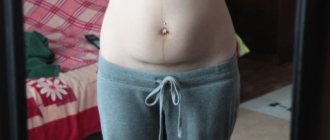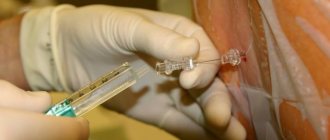Baby and mom after caesarean section
Unlike natural childbirth, the birth of a child by cesarean section has a number of features. After completion of the operation, the patient is allowed to turn from one side to the other no earlier than after 1.5-2 hours. It depends on the method of pain relief and the condition of the mother. After 6 hours, she will be able to sit, stand and walk around the room. In this case, all movements must be smooth and very careful.
During the first day after surgery, most women are already able to independently care for themselves and care for the baby. After 10-12 hours from the end of labor, the patient is transferred to the postpartum ward. During this period, it is very important for mother and child to stay together.
Along with this, being together with the baby helps to accelerate the production of breast milk. Lactation processes during natural and artificial childbirth are somewhat different. Often, after a cesarean section, new mothers have problems with the mechanism of lactation development. Due to the lack of privacy with the baby, women periodically experience problems with breast milk production.
In modern medicine, epidural and spinal anesthesia are often used during caesarean section. Such methods of pain relief allow the mother in labor to feed the newborn right in the delivery room. In cases where the operation is performed under short-term and shallow anesthesia, babies, as a rule, are put to the breast immediately after the patient comes out of medicated sleep.
Some doctors believe that the inability to make tactile contact and attach a baby to the breast in the near future after birth negatively affects sucking activity, causing the baby to become apathetic and often refuse to feed. Others are convinced that the success of feeding is not related to when exactly a woman puts her baby to her breast for the first time.
Consequences for mother and child in the future
Complications can arise not only in the postoperative period. In some cases, the consequences of this method of delivery make themselves felt even after many years. For a woman they manifest themselves as:
- Digestive disorders.
- The need for subsequent births to be carried out in the same way. Only in rare cases do doctors deviate from this rule.
- Adhesive disease. Adhesions can cause intestinal tug and weaken the ligaments that hold the uterus, ovaries and tubes together. As a result, tubal infertility and intestinal obstruction develop. In addition, the process of defecation becomes difficult and the uterus bends or bends, which negatively affects the menstrual cycle.
- Violations of the emotional connection between mother and baby. It is believed that Caesarean babies are less attached to their mothers than babies born naturally.
- Formation of a postoperative hernia at the site of a surgical scar.
- Discrepancies, decreased tone and loss of functionality of the rectus abdominis muscles.
- Endometriosis.
Children born by cesarean section often suffer from the following diseases and conditions in childhood and adulthood:
- food allergies,
- excessive emotional excitability and hyperactivity,
- lack of weight,
- asthma,
- respiratory dysfunction,
- delayed psychophysical development,
- hyaline membrane disease,
- pneumonia,
- disruption of the process of formation of basic perinatal matrices, which affects the body’s ability to withstand stress, emotional connection with parents and integration into adulthood.
Caesarean section babies

How are Caesar babies different from children born naturally? This is a question my parents often ask me.
At the same time, mothers themselves often describe a number of features: there are frequent difficulties with digestion, since the child did not pass through the birth canal, and his digestive system was not populated with the necessary flora; frequent lung diseases are possible; allergic reactions are common; there are problems with maintaining attention; children do not like novelty and have difficulty establishing relationships; they subjugate people with their behavior; They begin any task with resistance, even something they know well.
I'll tell you more.
Caesarean children have one feature - the speed of adaptation to any situation. But, as often happens, a weakness in one turns out to be a strength in another. The world unexpectedly collapsed on them at the time of childbirth, which often leads to a wary attitude towards everything new. They are not very experimental. For example, going down a slide for the first time can be a challenge for them, but once they overcome it, they can develop this skill with great pleasure.
Often a baby after a cesarean section tends to take things to the extreme . Children with difficulties in emotional manifestations will often drive their parents into an emotional state. This is unpleasant for them, but it is understandable, and this is how they trigger their emotional reactions. This is a kind of jerk - the same thing a horse does to move a heavy cart. As I go, it becomes easier.
Children who have difficulty with motor skills are very often hypermotor , and then they need to be caught.
All these differences are very well compensated by training. This is why Caesarean children in different families are so different from each other. For example, in families where children like to be cuddled, where there is a lot of physical contact, the child learns to quickly and adequately respond at the motor level. In families where emotions are strong, the child learns to react appropriately emotionally. In families with a high intellectual level, the child thinks very soberly and beyond his age. Where the table is varied, the child learns to enjoy gastronomic delights.
Training and more training.
These children need significantly more moments of personal success and understanding. They then believe they can and subsequently level themselves out to a greater extent. Parents just need to help start the movement.
Caesarean children often become better than many of their peers in their areas of success. This is due to the fact that they do not like change, want to stay in their comfort zone and at the same time need more powerful encouragement. They earn it hard, pumping themselves to a high level in one area.
WHAT TO DO?
Is it possible to compensate for this and is it necessary? Yes, it is possible, but whether it is necessary is up to each family to decide for itself. Have you decided to help your child? Then pay attention to a few simple recommendations.
- Provide age-appropriate assistance. So, a four-month-old baby who feels and licks everything (these are his needs at this age) needs a more saturated space: many toys and objects around, different in texture and shape.
- Initially push to study. Caesar babies are often less active in their cognitive activity. For example, they don’t put toys in their mouths at all or do so little. They tend to choose one way of obtaining information for themselves. This needs to be given special attention. I have not seen a single Caesar who did not easily look at new things or listen to new things. In these systems there is constant training in a natural way. But putting on new clothes is often difficult. And at the same time, I have not seen such a feature in children whom their parents loved to dress and used various costumes in games. Even the mother’s “fad” for clean clothes and frequent changes of vests, T-shirts, etc. accustom the child to this. Such methods of compensation work in the first years of life, when the child gradually builds different systems.
- This might happen - we didn’t have time. At an older age, you need to use the child's strengths as a motivator . If a child has success in the motor sphere, then this is a stimulus for cognitive activity. Play something like the game “Cossacks - Robbers”, where the child will be very happy to keep the rules and follow them. At first not for long, then more and more. In this game you can teach writing, reading, and counting. Anything you can think of.
In my practice, I laid out legends in numbered boxes that helped the child get to the prize. He had problems with counting. To understand which box the next clue was in, he had to subtract or add the number of the previous one and the one he was exploring now. If a child is smart beyond his years, then this can be used as an incentive in any area, but you need to find a conscious motive.
Let's imagine a child fascinated by the underwater world. He watches a lot of popular science films and reads books—a gift for his parents. This hobby will help develop fine motor skills (make scuba gear from plastic bottles). You can climb a stepladder and look through binoculars (developing endurance). The ship is running out of food, and all you have left is... It must be a healthy product that the child never dared to try. If you don’t like it, you won’t eat it, but it will be a choice, not a refusal.
The severity of the characteristics of such a child depends on his activity from the very beginning of life. If you give a child a massage, then each massage technique should lead to a response: not just stroking, but rather tickling; kneading the muscle not for the sake of improving blood supply, but in order to gain and maintain tone (which is not easy for such children). So, we stretch your leg and at the same time the child pushes you. You can also train the vegetative sphere: contrasting dousing with water with a temperature difference of 10-15 degrees (perceptible to the hand).
In adulthood, it is also possible to develop compensation, but the goal here is very important, for the sake of which a person agrees to leave his comfort zone , to something new for himself. It is often difficult and unpleasant, but it is the only way. And again: this is typical for any person, but our hero is more pronounced, so he needs to be encouraged and supported a little more.
Let's end with the fact that a caesarean section is done according to indications, and it is justified, and we can thank the doctors for this. At a minimum, the child was saved from serious pathology. In this case, peculiarities may arise, but there is always a chance to correct, change and compensate for them. And it is not necessary to run to all the specialists for this.
I have repeated it many times and will repeat it: the most successful rehabilitation therapists are parents . The art of small steps every day.
Try it!










